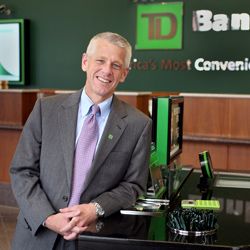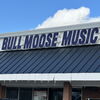Answering the call | TD Bank's new call center pushes customer service as a competitive edge
 Photo / Tim Greenway
Larry Wold of TD Bank
Photo / Tim Greenway
Larry Wold of TD Bank
A call center may bring to mind endless rows of cubicles enclosing a sea of workers in headsets, stuck with the thankless job of being just another anonymous voice at the other end of the line.
This vision of call centers as “dark, dingy sweat shops,” as Larry Wold, TD Bank’s Maine president, puts it, may be a prevailing stereotype, but it’s an increasingly outdated one. TD Bank’s lavish new center in the Auburn Mall turns the impression of the call center as the epitome of modern soullessness on its head.
Last year, TD Bank spent $16 million to renovate its 60,000-square-foot anchor space in the mall, which had been vacant since the department store Steve & Barry’s went bankrupt in 2008 and moved out. By signing a 10-year lease, the bank avoided building a new structure — part of its environmental agenda — and also boosted the local economy by concentrating hundreds of workers in Auburn’s retail service center.
The move emphasizes the role the bank’s call centers play in its competitive strategy. Often the first point of contact between a customer and a company, call centers and their impressions count.
“They’re often customers’ first — and sometimes their only — human interaction with a company,” writes Kerry Bodine, an analyst with Cambridge, Mass.-based Forrester Research Inc., in her February 2011 report, “Reinvent Your Call Center Culture to Create Amazing Customer Experiences.” Call centers can help garner customer loyalty, bolster brand image and increase revenues, Bodine writes, but customers regularly report less satisfaction with call center agents than with branch or store employees. Her research shows phone satisfaction levels have dropped for four straight years across most industries, with only investment firms, credit card providers and banks bucking the trend, with satisfaction rates climbing slightly between 2009 and 2010.
For banks, Bodine’s research shows that 74% of customers report being satisfied with service from call center agents, versus 86% of customers who say they are pleased with their interactions with employees at bank branches. TD intends to break the banking industry average on caller satisfaction, providing an experience that will give it an edge.
“Our business is so competitive,” says Wold, “you can’t differentiate yourself on products or pricing, so you have to find ways to compete that are difficult to imitate.”
Difficult to imitate and to finance. Colin Taylor, CEO of The Taylor Reach Group Inc., an international call center consulting firm based in Toronto, (also home to TD Bank’s parent, TD Bank Financial Group) says the $16 million TD Bank invested to create a new center is 30% to 50% greater than what is typical for call centers.
But it could be money well spent. There is a direct correlation between employee satisfaction and attrition rates, which are a “huge issue for call centers,” Taylor says. Data from ContactBabel’s 2011 report, “U.S. Contact Center Decision-Makers’ Guide,” shows the national mean for staff turnover at call centers is 32%, with the finance sector averaging 33%, meaning roughly one-third of employees leave per year. Taylor says each of those lost employees represents a financial loss to a company of $5,000 to $7,000, based upon recruiting, training and time to achieve job competence. “Labor is the single largest expense, so everything they can do to make the agents feel better will pay positive dividends on reducing attrition and defection,” he says.
Wold says TD Bank’s motto, “America’s most convenient bank,” is a promise to the customer and a challenge to the bank’s employees. “This is the kind of investment it takes to deliver on that promise,” he says.
Lowering attrition
From the mall parking lot, the most prominent aspect of the call center is its long row of large windows that flood the center with natural light and reduce its dependency on light bulbs. The center has earned LEED platinum status, and reportedly emits 170 fewer tons of carbon dioxide than most call centers, according to Jacquelynn Henke, TD Bank’s real estate green strategy officer.
The front doors open to an elegantly lit entrance designed by Auburn’s Harriman Architects and Engineers, with curving walls, a bold color scheme of emerald green and dusky blue, a small garden of native plants and cherry-wood chairs by Auburn-based Thos. Moser Cabinetmakers.
The huge space, a decade ago the home of a Porteous department store, has been sectioned into four “neighborhoods,” each with its own color scheme: purple, green, orange and blue. Color-coded carpets made from recycled yarn delineate the quarters. Besides creating a cozy Mr. Rogers’ feel, the neighborhoods also make it easier to locate a single worker among the 500 seats, according to Matt Madden, the call center manager. “It’s easier to refer to the purple neighborhood, third street over, rather than ‘that seat over there,’” he says.
The center is split by “Main Street,” a wide aisle bisecting the room that leads to a circular platform — “center stage” as it’s called — which is the command center where all calls are routed to agents. This platform is bathed in light from a 40-by-40-foot-wide skylight. Wall-length murals depict the spring and fall seasons, bringing more color to the already bright space. A whooshing sound from an unseen white-noise machine helps soften the murmur of hundreds of people talking at once. And a few employees stand rather than sit, their adjustable desks raised chest high so they can work more comfortably if they have back pain.
When they are ready to break, either for one of their two 15-minute breaks or their half-hour lunch, workers can play Nintendo Wii in the lounge, or sit together in the funky eating space with a checkered floor and private side rooms. Or, they can head into the adjoining mall to eat at one of its restaurants or shop in its stores.
“You want to create an environment where top performers are happy and content where they are,” Taylor says. “The environment you create is part of that, policies and procedures are part of that, and how the center is managed on a day-to-day basis is part of that.”
Not only does this create a competitive business advantage, Taylor explains, but it also helps a call center compete with nearby employers for quality workers. Over the last two decades, more companies have moved their call centers into secondary and tertiary markets where they can build good relationships with local communities and decrease turnover rates. But even in rural markets that promise reliable workers at relatively low wages, “you’ll still find labor competition with tourism, lumber, or fishing or Walmart, and it really becomes a retention game,” Taylor says.
Opening its doors
TD Bank opened its call center last summer, and in the ensuing months expanded its work force from 250 to 500. It had previously operated a call center in Lewiston at the Fairgrounds Business Park and maintains a back-office and processing operation in that city’s Bates Mill complex. Madden says more than 1,000 people applied for the 250 job openings, which start at $11 an hour and include dental and health benefits for full-time workers (three-fourths of the staff are full time), and a 100% 401(k) match.
While the call center’s attrition rates are proprietary information, according to Wold, Madden says the rate is lower than at other call centers.
Besides doubling its staff, the bank extended its daily schedule by a few hours, and is now open from 5 a.m. to 2:30 a.m., following industry data showing that customers demand service around the clock. About 1,300 people are employed at TD’s three call centers in Mt. Laurel, N.J., Springfield, Mass., and Auburn, with 1,100 working the phones. “We come close to overstaffing. If [customers] wait a long time, they may not have a good experience,” Wold says. The three centers act as a virtual call center, linked together to function as one mega-site to address callers’ questions or concerns as quickly as possible.
The growth was necessary to accommodate the bank’s recent rapid expansion, he says. TD Bank Group acquired Cherry Hill, N.J.-based Commerce Bank in 2008, rebranding as TD Bank, and in 2010 it acquired The South Financial Group Inc. and its subsidiaries, Carolina First Bank and Mercantile Bank. TD has extended its territory all along the East Coast, and has 1,250 locations from Maine to Florida and 6.5 million customers. As the company grows, its call centers must keep up. “The growth expectations are that as the company expands its footprint and fills in along the East Coast where we have gaps … we’ll have to support that growth,” Wold says. Currently, the bank’s three North American call centers handle 30 million calls per year, which averages about 100 calls a day per agent.
And the call centers are not yet at full capacity. About 300 more agents can be added at the Auburn center, bringing the total work force there to 800.
When TD Banknorth merged with Commerce Bank, there was concern in Lewiston and Auburn that TD might shift its Maine-based operations south. But the $16 million investment in its new call center should reassure any worriers, according to Auburn Economic Development Director Roland Miller. “Any time you have an investment at this level and a longer-term lease commitment, this solidifies their position here,” he says.
The bank reinforced this point when it brought in a 9-ton boulder to plunk down in the middle of the Auburn call center. The unpolished rock, mined from Christian Hill quarry in Auburn, represents TD Bank’s “solid commitment to Maine and to its customers,” Madden says. “Solid as a rock.”
TD Bank (The U.S. personal and commercial banking business segment of TD Bank Group)
Headquarters: Cherry Hill, N.J., and Portland
Maine president: Lawrence Wold
Founded: 1852 as Portland Savings Bank
Employees in Maine: 3,100; 500 in the Auburn call center
Total assets: $179 billion
Rebecca Goldfine, Mainebiz staff writer, can be reached at rgoldfine@mainebiz.biz.










Comments